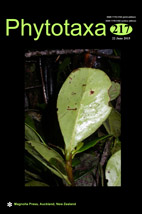Abstract
Records of 48 species belonging to the order Arthoniales from Bolivia are presented. Cryptothecia rosae-iselae Flakus & Kukwa and Lecanactis minuta Ertz, Flakus & Kukwa are described as new to science. Thirty-seven species are reported for the first time from Bolivia, seven of which, Alyxoria apomelaena, Cryptothecia darwiniana, C. groenhartii, C. megalocarpa, Herpothallon furfuraceum, Lecanographa uniseptata, and Opegrapha subvulgata, are new to South America. This raises the number of Arthoniales known from the country up to 72. Two new combinations are proposed: Alyxoria apomelaena (A. Massal.) Ertz for Opegrapha apomelaena A. Massal. and Myriostigma napoense (Kalb & Jonitz) Kukwa for Cryptothecia napoensis Kalb & Jonitz. Cresponea melanocheiloides is the second species of the genus shown to contain a xantholepinone. Cresponea melanocheiloides is reported as new to Costa Rica and Panama, Cryptothecia megalocarpa as new to the Netherlands Antilles and Guyana and C. striata is new to Colombia, Costa Rica, French Guiana and the Netherlands Antilles. Distribution data are reported for each species, with taxonomic remarks provided for new and some problematic taxa.

